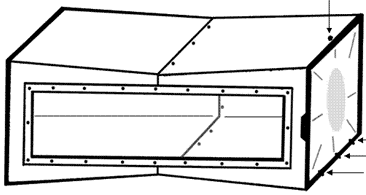Abstract
This paper describes an inexpensive and secure cage system for housing venomous snakes. The cages are easily constructed from commercially available plastic containers and are lightweight and can be stacked, minimizing the area needed to house numerous animals. They allow easy access to the animal and can be adequately disinfected. These cages can be individually locked and also allow for full viewing of the animal.
cage system; venomous snakes; security; lockable; lightweight
SHORT COMMUNICATION
A secure and economical system for caging venomous snakes
R. L. Powell
Department of Biological Sciences, Laboratory for Environmental Biology, University of Texas-El Paso, El Paso, Texas
Address to correspondence Address to correspondence R. L. POWELL Department of Biological Sciences, Laboratory for Environmental Biology, University of Texas at El Paso El Paso, Texas 79968 ripowell@utep.edu
ABSTRACT
This paper describes an inexpensive and secure cage system for housing venomous snakes. The cages are easily constructed from commercially available plastic containers and are lightweight and can be stacked, minimizing the area needed to house numerous animals. They allow easy access to the animal and can be adequately disinfected. These cages can be individually locked and also allow for full viewing of the animal.
Key words: cage system, venomous snakes, security, lockable, lightweight.
INTRODUCTION
Caging for venomous snakes must allow for the safety of the keeper, be easily maintained, and provide a secure and lockable system (1). Inadequate cages can pose a security and liability risk for the individual and/or institution that maintain venomous snakes. Inexpensive cages can be manufactured from wood. However, wood cannot be properly disinfected and can increase the risk of transferring infections between animals. Glass aquaria are economical and can be adequately disinfected but are heavy, easily broken, and are insufficient for security reasons. Bedocs et al. (2) described an inexpensive and easily manufactured cage system for housing large reptiles. However, these cages are not designed for the security needed for venomous snakes. There are commercially available cages that are secure and lockable but they are not cost effective if maintaining a large colony of animals.
I developed an inexpensive and secure cage system that can be constructed from commercially available square plastic containers. These cages can be manufactured in a relatively short period of time (45 minutes to 1 hour) and follow the guidelines for housing reptiles by the National Research Council (3). They allow for easy access of the reptile, can be easily disinfected, are lightweight, but are sturdy and each cage can be independently locked.
MATERIALS AND METHODS
I obtained 15 and 16 liter discarded plastic containers with lids and removed the metal handles. These containers are manufactured by various companies and are commonly used for shipping and storing detergents, cat litter, and various food products. Three 4.5 mm holes were drilled 8 cm apart through the lid and container. Nylon cable ties (4 mm) (available at electrical supply stores or hardware stores) were threaded through the holes and secured tightly and the excess cable tie ends removed. The cable ties secure the lid firmly to the bottom and serves as a strong and durable hinge for the lid door. Opposite the hinged end a larger 6.5 mm hole was drilled in the middle through the lid and the container to allow for a lock. The remaining two sides of the lid snap firmly to the container body. This results in a firm, tight seal of the lid with the container on all four sides when closed and provides for an escape proof door.
Larger cages can be manufactured by connecting two containers end to end (Figure 1). Because the containers are slightly tapered, the bottoms can be cut out with a utility knife and one container can be inserted inside the other. I removed 4 cm more from the bottom of one of the containers and inserted the longer container tightly inside the shorter one allowing the containers to overlap 1.5 cm. Holes were drilled every 7 cm on three sides of the joined containers and 3 mm diameter aluminum rivets were used to attach the two containers together creating a strong, tight union. The larger containers require an additional lid on the opposite side that can be permanently attached with cable ties.
Diagram of large cage showing 6 mm lock hole (top arrow) and cable tie attachment positions (bottom three arrows).
An opening was cut in the front side of the container (14 cm x 28 cm for small cages-15 or 16 liter containers and 14 cm x 56 cm for large cages-2 x 16 liter containers). Plexiglas was cut to the appropriate size and attached with 3 mm aluminum rivets every 7 cm. Several 3 mm holes were drilled throughout the back of the container to ensure adequate ventilation.
The final product is a secure, inexpensive, lockable, lightweight, and easy to clean caging system (Figure 2). The cages can be stacked three to four levels high, which can minimize the room necessary to house numerous animals. The large side door allows easy access for cleaning purposes and removal of the animal. In addition, they are aesthetically pleasing and allow for full viewing of the animal for display if necessary. I have used these cages over a one-year period to house numerous small to medium size (20 cm to 100 cm) venomous snakes with no escapes.
Received January 1, 2002
Accepted May 14, 2002
-
1ALTIMARI W. Venomous snakes: a safety guide for reptile keepers. Herpetol. Circ., 1998, 26, 24.
-
2BEDOCS PM., MCBRAYER L., ELIAS J. An inexpensive method for creating cages for large reptiles. Herpetol. Rev., 2000, 31, 164.
-
3INSTITUTE OF LABORATORY ANIMALS RESOURCES. Guide for the care and use of laboratory animals. 7th Washington: Commission on Life Sciences. National Research Council. National Academy Press, 1996: 140p.
Publication Dates
-
Publication in this collection
09 Dec 2003 -
Date of issue
2003
History
-
Received
01 Jan 2002 -
Accepted
14 May 2002



